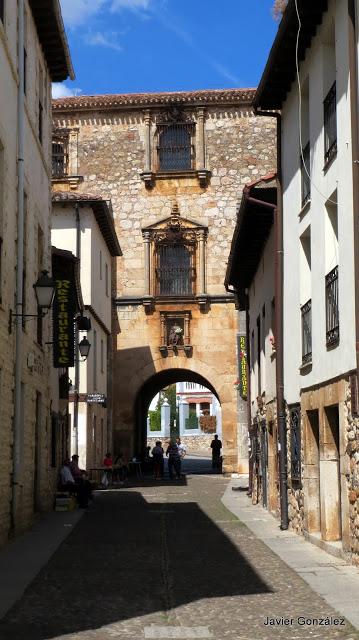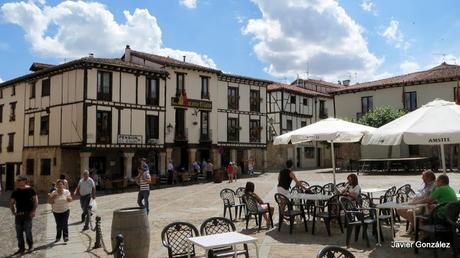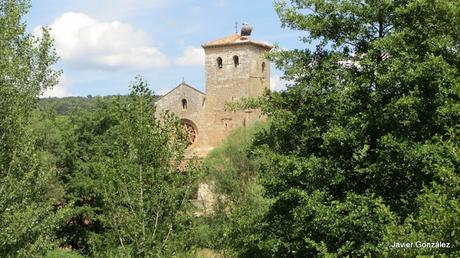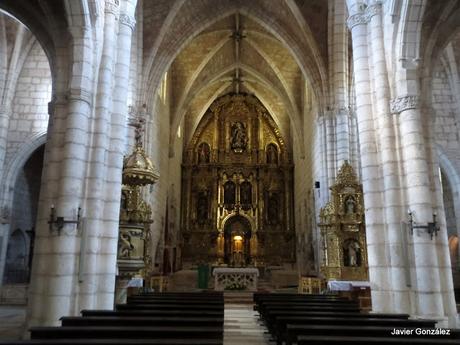
Covarrubias es una pequeña villa de Burgos, España, famosa por sus casas de mortero y entramado de la época Medieval. Esto fue lo que en un principio me llevó a visitarla.
Pero mi sorpresa fue mayúscula cuando al llegar vi que el río Arlanza, que atraviesa el pueblo, era de un color uniformemente naranja como si de una espesa sopa de zanahoria se tratara. No creo que muchos visitantes hayan tenido la suerte de ver este color del río. Para mí fue un misterio hasta que encontré que la razón de este color es debido a las arcillas disueltas aguas arriba que arrastra en época de lluvias.
En esta entrada podréis ver este inusitado color de un río pero además todas las otras razones por las que hacen tan interesante este pueblo.
Covarrubias es uno de los mejores ejemplos de la arquitectura popular castellana. Por el pueblo pasa el Camino de Santiago, y está situado en la Ruta de la Lana y en el Camino del Cid. De origen medieval, la villa fue fundada por el rey visigodo Chindas Vinto, sobre los restos de un castro romano. El primer conde de Castilla, Fernán González y su hijo, el conde García Fernández, hacia el siglo X, convirtieron Covarrubias en capital del primer Infantado de Castilla.En Otoño, se celebra un importante acontecimiento cultural llamado "Pretexto Covarrubias", donde se dan cita personalidades ilustres iberoamericanas, vinculadas al idioma castellano como Mario Vargas Llosa por ejemplo, y muchos pensadores y escritores de la lengua castellana. Está dedicado a la reflexión de la comunicación en español.
Covarrubias is a little village of Burgos, Spain, famous for its houses mortar and timber from the Medieval Ages. This was what originally led me to visit.
But my surprise was great when arriving saw the Arlanza river, running through the village, was uniformly orange like a thick carrot soup is involved. I do not think that many visitors have been lucky enough to see this color of the river. For me it was a mystery until I found that the reason of this color is due to the dissolved clay upstream drag during the rainy season.
In this post you can see this unusual color of a river but also all the other reasons that make this town so interesting.
Covarrubias is one of the best examples of Castilian architecture. Through the village goes on the Camino de Santiago, and is located in the Route of the Wool and the Camino del Cid. With medieval origin, the town was founded by the Visigoth king Chindas Vinto over the remains of a Roman fort. The first count of Castile, Fernán González and his son, Count Garcia Fernandez, to the tenth century, became Covarrubias as the first capital of Infantry of Castile.
In Autumn, a major cultural event called "Pretext Covarrubias" is celebrated, where there is an appointment Latin American illustrious personalities linked to the Castilian language as Mario Vargas Llosa for example, and many thinkers and writers of the Spanish language. It is dedicated to the reflection of communication in Spanish.
RECOMENDACIÓN MUSICAL
Imaginaos el Misere Mei Deus de Gregorio Allegri reverberando entre los muros de la Colegiata de Covarrubias, igual que lleva haciéndolo en la Capilla Sixtina cada Semana Santa desde que se compuso. Uno de los más bellos misereres jamás escritos
--------------------------------------------------
Imagine the Miserere Mei Deus by Gregorio Allegri reverberating within the walls of the Collegiate Covarrubias, as has been doing in the Sistine Chapel every Easter since it was composed. One of the most beautiful ever written misereres
El río naranja
Orange river
Covarrubias debe su nombre a las cuevas rojizas que abundan en los alrededores que el agua arrastra en la época de lluvias.



Casas medievales de entramado
Medieval timbered houses
Su recinto urbano, declarado Bien de Interés Cultural, es uno de los mejores exponentes del urbanismo típico castellano de calles porticadas y casas con entramado de madera. Ésta habitualmente de enebro o sabina, se tiñe de un hermoso color oscuro y aportan a la vivienda un ambiente cálido así como un aroma muy agradable.
Fueron los siglos XV y XVI los de plenitud para esta localidad. La prosperidad de la abadía y de la villa así como la situación de privilegio con la que contaban da lugar a una clase acomodada de clérigos e hidalgos cuyas acciones dejarán su huella en la vida pública de España.
El Conde Fernán González, su hijo Garci Fernández, su nieta Doña Urraca, aguerridos contrincantes como Almanzor, Abd al-Rhaman III y muchos otros, llenan las páginas de las crónicas de esta magnífica población, centro geométrico en la fundación del Condado de Castilla y eje fundamental de la Reconquista.
Cuna de personajes importantes, en ella nació en 1524 el Dr. Divino Vallés, médico personal de Felipe II.
Its urban area, declared of Cultural Interest, is one of the best examples of typical Castilian urban arcaded streets and half-timbered houses. This one usually juniper, is tinged with a beautiful dark color and provide housing a warm atmosphere and a very pleasant aroma.
It was the fifteenth and sixteenth centuries of fullness for this location. The prosperity of the abbey and the town as well as the privileged position they had lead a wealthy class of clerics and noblemen whose actions will leave their mark on public life in Spain.Fernan Gonzalez, his son Garci Fernández, his granddaughter Doña Urraca, seasoned opponents as Almanzor, Abd al-Rahman III and many others, fill the pages of the history of this magnificent city, geometric center in the foundation of the County of Castile and cornerstone of the Reconquista.
Cradle of important characters, it was born in 1524 Dr. Divino Vallés, personal doctor of Felipe II.
Casa de Doña SanchaMs. Sancha's house
Es el máximo exponente de la arquitectura tradicional de la villa. Data del siglo XV. Fachada de adobe y clásico entramado de madera. El amplio soportal y su balconada son increíbles aprovechamientos climáticos, el uno para proteger del sol y la otra para disfrutar de él.
It is the maximum exponent of the traditional architecture of the villa. Dates from the fifteenth century. Classical facade of adobe and wooden framework. The spacious porch and balcony are amazing climate benefits, the one for protection from sun and the other to enjoy it.

Arco de entrada y Archivo del Adelantamiento de Castilla y oficina de turismo
Archway and Archive Advancement of Castile and tourist office
Construido en la segunda mitad del siglo XVI por mandato de Felipe II, es de estilo herreriano con decoración renacentista, consiste en un gigantesco prisma pétreo con base rectangular, sostenido con ocho contrafuertes. Asemeja a un hórreo gallego de grandes dimensiones, pero en el que se ha excluido, por completo, la madera, con el fin de evitar posibles incendios.
Este edificio fue un centro de documentación de todas las escrituras que emanaban del Adelantamiento de Castilla, cuyo tribunal y sede estaba en Burgos, pero en el siglo XVIII perdió su función, ya que todo lo que en él había fue trasladado al actual Archivo General de Simancas. La entrada de este archivo es conocida como Puerta Real, por ser la entrada principal a la Villa. Encima de ella, se puede ver el escudo de Felipe II, en el que destaca, por su gracia y rareza, el toisón de oro y se le considera el más perfecto y completo conservado y en él están representados todos sus estados. Las rejas de hierro de las ventanas y contraventanas son todavía las originales. Fue utilizado como Ayuntamiento, y hoy en día acoge la oficina de Información y Turismo, la Biblioteca municipal y una sala de Exposiciones.
Built in the second half of the sixteenth century by order of Felipe II, is Herrera style with Renaissance decoration consists of a giant stone prism with rectangular base, sustained eight buttresses. It resembles a large Galician horreo, but that has been excluded, fully the wood, in order to prevent possible fires.
This building was a center of documentation of all writings emanating from the Advancement of Castile, whose tribunal and was based in Burgos, but in the XVIII century lost its function, because everything in him was transferred to the current General Archive Simancas.
The entry in this file is known as Puerta Real, as the main entrance to the Villa. Above it, you can see the shield of Felipe II, which stands out for its grace and rarity, the Toisón de Oro and is considered the most perfect and complete, we retain of it. It lists all their states. The iron bars of the windows and shutters are still the originals.
It was used as City Hall, and today houses the Office of Information and Tourism, the municipal library and an exhibition hall.


Plaza Mayor
Main Square
Iglesia de Santo Tomás
Santo Tomás churchEsta iglesia fue construida en el siglo XII, pero de la original no queda apenas nada. La que hoy podemos observar es del siglo XV, aunque conserva algún resto de la original en la nave derecha.
En el templo de Santo Tomás se conserva el órgano que aunque menos antiguo que el de la Colegiata, ya que este data del siglo XVIII, sigue sonando increíblemente, sobre todo los clarines que son dignos de oir.
This church was built in the seventeenth century, but the original is not just anything. Which we see today is the fifteenth century, but retains any remains of the original in the right aisle.In the temple of St. Thomas the organ though less ancient than the Collegiate preserved, as this XVIII century, still incredibly sounding, especially bugles that are worth hearing.


Torreón de Fernán González
Fernán González's tower
Fechada en el siglo X está considerada como obra mozárabe. Cuenta la leyenda que la infanta doña Urraca fue encerrada y emparedada aquí por su propio padre Fernán González, como castigo por sus amoríos con un pastor. Motivo por el que también se le conoce con el nombre de Torreón de doña Urraca o Torre de "La Emparedada".
En su momento constituyó un elemento defensivo de la villa. De base rectangular, y torre piramidal truncada, con gruesos muros de hasta 4 metros de espesor en la base sustentados por recios bloques provenientes de construcciones anteriores.
Por sus pequeñas saeteras los arqueros hacían blanco sobre el enemigo, mientras que desde los matacanes se arrojaba agua o aceite hirviendo.
Dating from the tenth century is considered Mozarabic work. The legend says that the Infanta Dona Urraca was locked and walled here by his own father Fernan Gonzalez, as punishment for his affair with a pastor. Reason why is also known by the name of Urraca Tower or Tower of "The Walled".
At the time it was a defensive element of the villa. Rectangular base, and truncated pyramidal tower, with thick walls up to 4 meters in thickness at the base supported by sturdy blocks from previous constructions.For its small loopholes archers made target on the enemy, while from the battlements boiling water or oil was thrown.


Colegiata
Durante el siglo XV se reedifica la nueva colegiata, mostrando la riqueza del gótico burgalés. En el siglo XVI se añade el claustro sustituyendo al románico anterior. Y ya en el siglo XX, un gran incendio amenaza con la destrucción de la Colegiata, pudiéndose salvar todo el tesoro gracias a la rápida actuación de los vecinos.
La Colegiata de San Cosme y San Damián se construyó partiendo de otra iglesia anterior románica. La nueva es del siglo XV, gótica. En los panteones de la colegiata están las familias más ilustres de la villa. En el presbiterio se encuentra el del conde Fernán González y su esposa Doña Sancha, un sepulcro hispanorromano del siglo IV. En el claustro, construido en los primeros años del siglo XVI, está el sepulcro gótico de la infanta Cristina de Noruega, primera esposa del infante Felipe, hermano de Alfonso X el Sabio. En la iglesia destaca el retablo principal barroco y el órgano del siglo XVII, el más antiguo de Castilla que sigue sonando.. Posee una gran variedad de piezas de arte sacro: capiteles románicos, tablas de Berruguete, Van Eyck, orfebrería del célebre maestro Calahorra, ropas litúrgicas de los siglos XVI al XVIII y el extraordinario tríptico de la Adoración de los Magos, atribuido a un discípulo de Gil de Siloé.
During the fifteenth century the new collegiate church is built, showing the richness of Burgos Gothic. In the sixteenth century, replacing the previous Romanesque cloister is added. And in the twentieth century, a big fire threatens the destruction of the Collegiate, being able to save all the treasure thanks to the rapid action of the neighbors.
The Collegiate Church of Saints Cosmas and Damian was built based on other previous Romanesque church. The new is the XV century Gothic.In the vaults of the collegiate are the most illustrious families in the village. In the presbytery is the Count Fernan Gonzalez and his wife Doña Sancha a hispanorromano tomb of the fourth century. In the cloister, built in the early sixteenth century, it is the Gothic tomb of princess Cristina of Norway, the first wife of the infant Felipe, brother of Alfonso X the Wise. In the church the main altarpiece and organ Baroque seventeenth century is the oldest of Castile that still sounds. It has a variety of pieces of sacred art: Romanesque capitals, tables of Berruguete, Van Eyck, goldsmithing of famous master Calahorra, liturgical vestments from the XVI to XVIII and the extraordinary triptych of the Adoration of the Three Wise Kings, attributed to a disciple of Gil de Siloé.




Mejores restaurantes según Tripadvisor
Tripadvisor best restaurants

Mejores hoteles según Tripadvisor
Tripadvisor best hotels

El Tiempo
Weather Forecast
Cómo llegar
How get it
